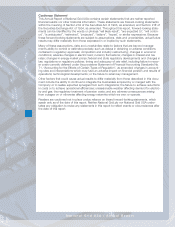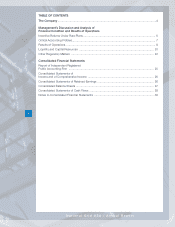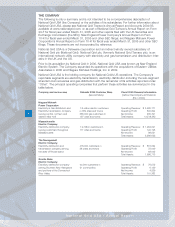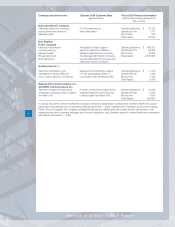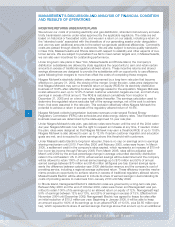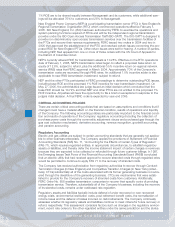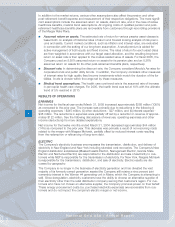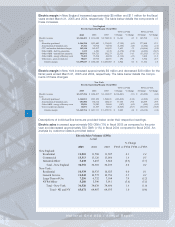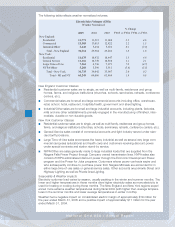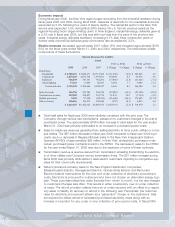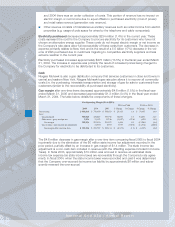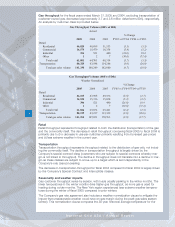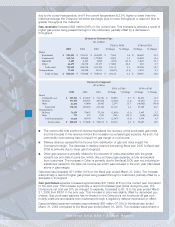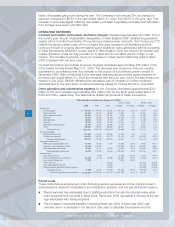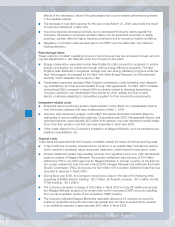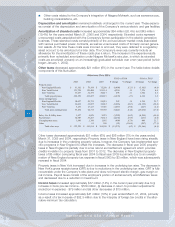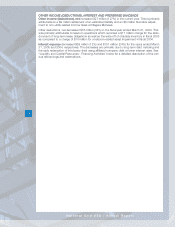National Grid 2005 Annual Report Download - page 9
Download and view the complete annual report
Please find page 9 of the 2005 National Grid annual report below. You can navigate through the pages in the report by either clicking on the pages listed below, or by using the keyword search tool below to find specific information within the annual report.
In addition to the market returns, various other assumptions also affect the pension and other
post-retirement benefit expense and measurement of their respective obligations. The more signifi-
cant assumptions include the assumed return on assets, discount rate, and in the case of retiree
healthcare benefits, medical trend assumptions. All ongoing costs of qualified pension and post-
retirement healthcare benefits plans are recoverable from customers through reconciling provisions
of the Merger Rate Plans.
■Assumed return on assets. The estimated rate of return for various passive asset classes is
based both on analysis of historical rates of return and forward looking analysis of risk premi-
ums and yields. Current market conditions, such as inflation and interest rates, are evaluated
in connection with the setting of our long-term assumption. A small premium is added for
active management of both equity and fixed income. The rates of return for each asset class
are then weighted in accordance with our target asset allocation, and the resulting long-term
return on asset rate is then applied to the market-related value of assets. For fiscal 2005, the
Company used an 8.50% assumed return on assets for its pension plan and an 8.26%
assumed return on assets for its other post-retirement benefits plans, respectively.
■Discount rate. In determining the discount rate, the Company considers Moody’s Aa rates for
corporate bonds and public utility bonds. In addition, the Company considers other measures
of interest rates for high quality fixed income investments which match the duration of the lia-
bilities. A rate is chosen within the range set by these measures.
■Medical trend assumptions. The health care cost trend rate is the assumed rate of increase
in per-capita health care charges. For 2005, the health trend was set at 10% with the ultimate
trend of 5% reached in 2010.
RESULTS OF OPERATIONS
EARNINGS
Net income for the fiscal year ended March 31, 2005 increased approximately $288 million (108%)
as compared to the prior year. The increase was primarily due to reductions in the following (i)
operating expenses - $345 million, (ii) other deductions - $27 million, and (iii) interest expense -
$38 million. The reductions in expenses were partially off set by a reduction in revenue of approxi-
mately $122 million. See the following discussions of revenues, operating expenses and other
income (deductions) for more detailed explanations.
Net income for the twelve months ended March 31, 2004 decreased approximately $44 million
(14%) as compared to the prior year. This decrease was primarily a result of non-recurring costs
related to the merger with Niagara Mohawk, partially offset by reduced interest costs resulting
from the redemption or refinancing of long-term debt.
ELECTRIC
The Company’s electricity business encompasses the transmission, distribution, and delivery of
electricity in New England and New York including stranded cost recoveries. The Company’s New
England distribution subsidiaries (Massachusetts Electric, Narragansett Electric, Granite State
Electric and Nantucket Electric) are responsible for the distribution and sale of electricity to cus-
tomers while NEP is responsible for the transmission of electricity. For New York, Niagara Mohawk
is responsible for the transmission, distribution, and sale of electricity. Electric results are dis-
cussed by geography.
The Company is no longer in the business of electricity generation and has divested the vast
majority of its formerly owned generation assets (the Company still retains a nine percent joint
ownership interest in the Wyman #4 generating unit in Maine, which the Company is attempting to
sell). Since deregulation, electricity customers have the ability to choose an alternative supplier of
their electricity other than the retail distribution company serving that customer’s region. For cus-
tomers who have not chosen an alternative supplier, the Company procures power on their behalf.
These energy procurement costs (i.e. purchased electricity expenses) are recoverable from cus-
tomers and do not impact the company’s electric margin or net income.
9
National Grid USA / Annual Report


